- Last Updated: December 16th, 2025
Key Takeaways
To win a PCB litigation trial, lawyers must review documents carefully, including company records and correspondence about PCBs. They'll often use expert witnesses like scientists who know all about the health risks and environmental impact of PCB pollution.
During a PCB contamination trial, attorneys gather evidence such as medical reports showing health problems from exposure to PCBs, proof of where the pollution happened through soil and water tests, and any past legal actions or agreements tied to the toxic chemicals.
For those facing cases involving PCBs in things like school buildings or local water sources, it's super important to understand what laws apply. Lawyers examine federal and state rules on toxic substances when making their case against companies that made or used PCBs.
How do you Prepare for a PCB Litigation Trial?
Question: How do you prepare for a PCB litigation trial?
Answer: Preparing for a PCB litigation trial involves gathering evidence, understanding the history of PCBs, seeking expert advice, and building a comprehensive case.
On this page, we’ll discuss this question in further depth, an overview of what a PCB litigation trial is, challenges involved in preparing for a PCB litigation, and much more.
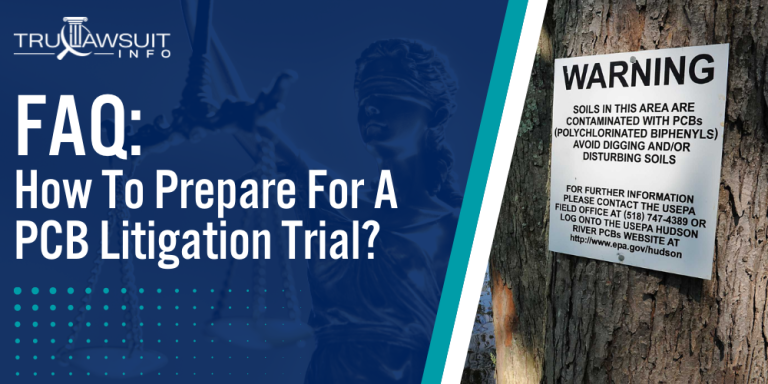
Intro to The PCB Litigation Trials
It is essential to review manufacturer knowledge and warnings, use credible scientific studies as evidence, and tackle technical causation problems related to PCB chemistry.
Furthermore, understanding statutes of limitations and seeking prompt medical treatment can strengthen your case.
If you or a loved one has experienced adverse health conditions after being exposed to PCB chemicals, you may be eligible to pursue compensation.
Contact TruLawsuit Info today using the chat on this page to receive an instant case evaluation.
Preparing to File in the PCB Litigation
Before filing a lawsuit related to polychlorinated biphenyl (PCB) exposure, plaintiffs should understand the complexities surrounding Monsanto Company Litigation and the specific challenges faced by School Districts and PCB Exposure.
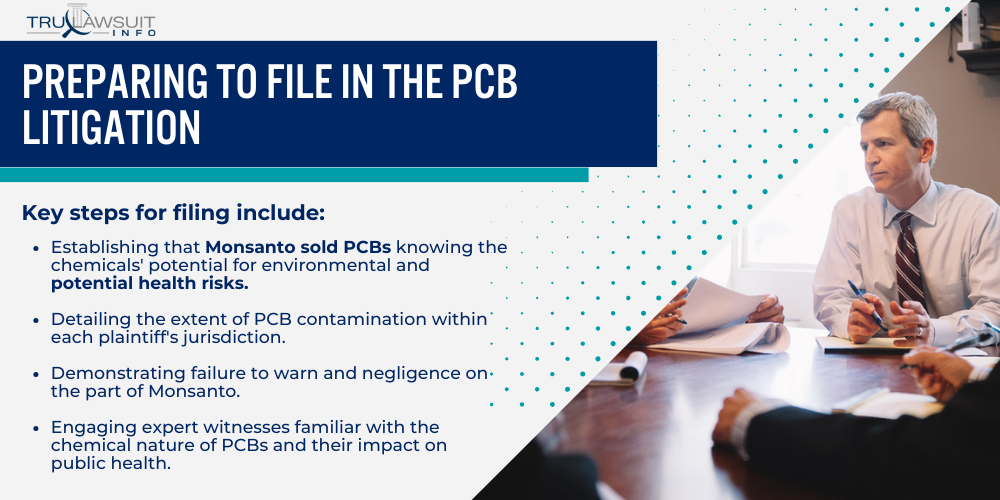
Monsanto Company Litigation
A comprehensive strategy is crucial when preparing to file litigation against the Monsanto Company.
Plaintiffs must consider various legal arenas, including the Delaware Supreme Court, Federal Court, and Superior Court.
Key steps for filing include:
- Establishing that Monsanto sold PCBs knowing the chemicals’ potential for environmental and potential health risks.
- Detailing the extent of PCB contamination within each plaintiff’s jurisdiction.
- Demonstrating failure to warn and negligence on the part of Monsanto.
- Engaging expert witnesses familiar with the chemical nature of PCBs and their impact on public health.
- Pinpointing the timeframe during which exposure occurred and the resulting damages.
- Navigating the admissibility of evidence based on previous Environmental Protection Agency findings.
School Districts and PCB Exposure
School Districts have their own unique set of challenges when joining the PCB litigation.
Notable cases such as those involving the Sky Valley Education Center and various Vermont Schools have underscored the potential for widespread PCB exposure in educational environments.
Essential preparatory steps for school districts include:
- Assessing the level of PCB presence in school buildings, particularly in districts like Burlington School District.
- Constructing a detailed chronology of PCB exposure for students and staff.
- Calculating the financial and health-related impact of PCBs within the school environment.
- Pulling together relevant documentation, including communications with Monsanto and internal maintenance records.
- Collaborating with state agencies and regulators, such as state Departments of Education and the Environmental Protection Agency.
- Involving medical professionals to substantiate claims of adverse health effects due to PCB exposure.
Understanding these specifics will significantly influence the success of actions taken against the Monsanto Company by various entities, including school districts affected by PCB contamination.
The Science of PCB Chemical Exposure
Understanding the intricate details of PCB exposure and the subsequent health risks is essential for evaluating the complex legal landscape surrounding polychlorinated biphenyls (PCBs).

Chemical Properties of Polychlorinated Biphenyls
Polychlorinated biphenyls (PCBs) are a group of synthetic organic chemicals that contain 209 individual compounds known as congeners.
Each congener possesses:
- A biphenyl structure consists of two benzene rings.
- One to ten chlorine atoms can be attached in various positions, affecting the toxicity and chemical properties.
- High chemical stability makes PCBs useful in industrial applications.
- Low flammability and insulating properties are beneficial for electrical equipment.
Despite these initially valued properties, PCBs are persistent in the environment and resist degradation.
They can remain intact and spread via air, water, and soil, leading to widespread environmental contamination.
Health and Environmental Impact of PCB Contamination
PCB contamination has been linked to a plethora of adverse health effects.
Significant exposure to these toxic PCBs can result in detrimental impacts on the reproductive systems and entail serious health risks.
PCBs have been found to:
- Disrupt endocrine function, which can lead to imbalances in hormone systems.
- Induce various types of cancer, with sufficient evidence linking PCBs to melanoma, liver, gallbladder, and biliary tract cancer.
- Causes immune system deficiencies, making individuals more susceptible to various diseases.
- Result in neurobehavioral and developmental disorders in children following in-utero exposure.
- This can lead to skin conditions such as chloracne, a severe skin rash caused by high levels of chlorine exposure.
Environmental impact is also profound; PCBs bioaccumulate in the food chain, impacting wildlife and ecosystems at large.
The resilience and longevity of these compounds make them an ongoing environmental and health challenge.
Addressing PCB Contamination: Preparing for the PCB Litigation
Polychlorinated biphenyls (PCBs), once prevalent as industrial compounds, have left a lasting impact on the environment and human health.
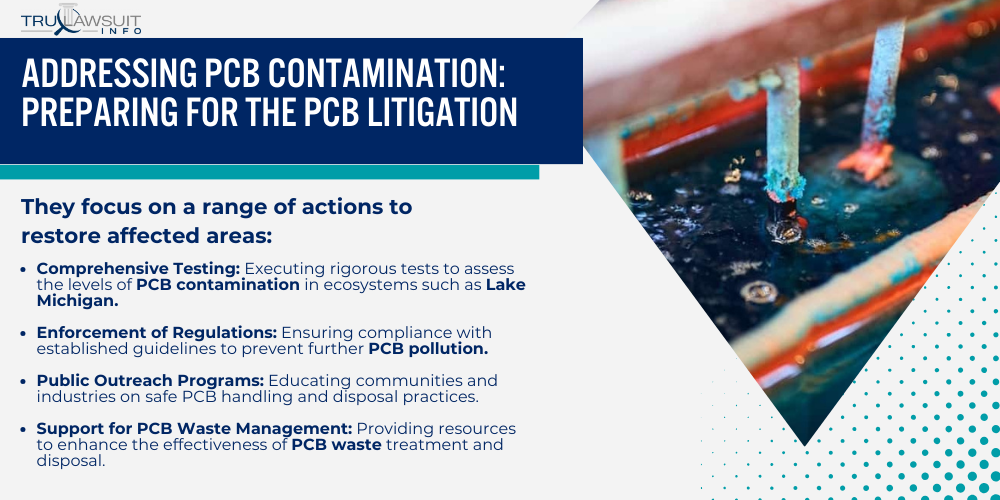
The preparation for PCB litigation is multifaceted, requiring considerable coordination between environmental remediation strategies and legal recourse to recover costs associated with PCB contamination.
Remediation Efforts: Environmental Protection Agency
The Environmental Protection Agency (EPA) plays a critical role in the cleanup of PCB pollution.
They focus on a range of actions to restore affected areas:
- Comprehensive Testing: Executing rigorous tests to assess the levels of PCB contamination in ecosystems such as Lake Michigan.
- Enforcement of Regulations: Ensuring compliance with established guidelines to prevent further PCB pollution.
- Public Outreach Programs: Educating communities and industries on safe PCB handling and disposal practices.
- Support for PCB Waste Management: Providing resources to enhance the effectiveness of PCB waste treatment and disposal.
Legal Strategies to Recover Costs in the PCB Litigation
PCBs or polychlorinated biphenyls are toxic chemicals that were used in various industrial applications.
If you or your company have been affected by the contamination caused by PCBs, this article will help you understand the legal strategies you can use to recover the costs incurred.
Legal teams focus on several strategies to hold responsible parties accountable and recover costs for addressing PCB contamination:
- Identification of Liable Entities: Determining which companies or entities contributed to the PCB pollution.
- Calculate Damages: Accurately quantify the damage to natural resources and public health.
- Negotiate Settlements: Discussed with responsible parties to reach an equitable settlement.
- Persevere in Litigation: Pursuing justice through the courts when settlements cannot be reached.
Within the context of Illinois, efforts such as the Illinois Environmental Protection Agency state’s PCB testing program are instrumental in identifying pollution sources and developing legal strategies as part of broader PCB litigation efforts.
The Role of Businesses and Manufacturers in PCB Litigations
In the context of PCB litigations, the roles of businesses, particularly manufacturers such as Monsanto, are of paramount importance as they often involve questions of product liability, environmental contamination, and public health risks.

Monsanto’s Role and Responsibility
Monsanto was a key player and the sole manufacturer of PCBs (polychlorinated biphenyls) in the United States.
Monsanto’s production of PCBs ceased in 1977, but the legacy of its actions continues to be the subject of litigation.
Entities that have sued Monsanto cite a variety of grievances, including environmental damage and health risks.
Specific allegations suggest that Monsanto:
- Sold and manufactured PCBs even after acknowledging the potential risks and hazards to public health and the environment.
- Was allegedly aware (Monsanto knew) of the risks associated with PCBs but intentionally misled the public and regulatory agencies.
- Is being held accountable for cleanup costs and damages related to PCB contamination in various lawsuits across the United States.
- Has been approached to agree to settlements to resolve these complex litigations.
The responsibility of Monsanto Company in PCB litigation often stems from this history of being the main producer and distributor of these chemicals.
Accountability of Other Entities
While Monsanto is frequently at the center of such legal disputes, accountability extends to other entities, including:
- Co-defendants in litigation that may have released PCBs into the environment.
- Manufacturers that included PCBs in their products.
- Disposal companies responsible for the proper disposal of PCB-containing materials.
- Local governments and private entities that must manage contaminated sites.
These stakeholders are also sued for their roles in the production, use, and disposal of PCB-containing materials, establishing a broad network of potentially responsible parties.
Each entity’s accountability is assessed in relation to their involvement with PCBs and the extent of their contribution to environmental and health issues stemming from PCB contamination.
PCB Litigations: Impacts on Communities and Ecosystems
Polychlorinated biphenyls (PCBs) are persistent organic pollutants that have been implicated in severe environmental and social setbacks.
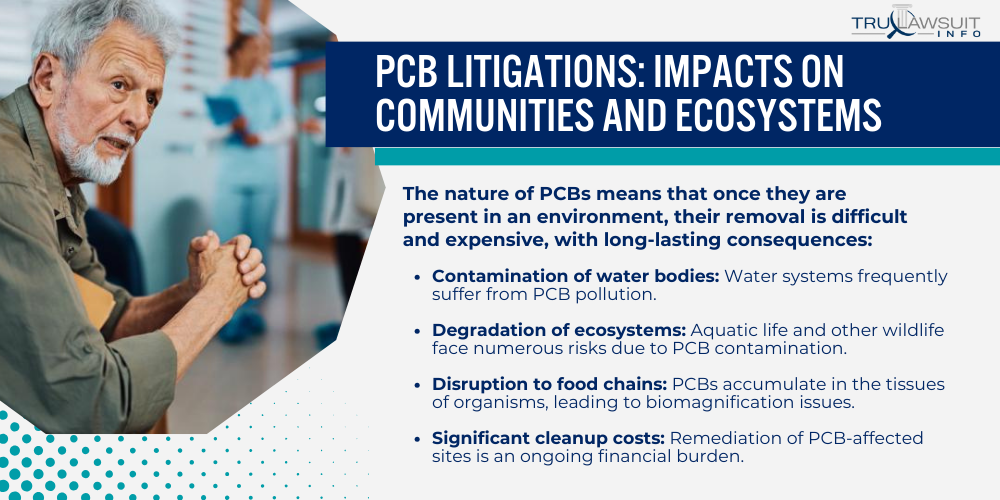
Communities facing PCB litigation confront not only ecological harm but also significant socioeconomic challenges.
Long-Term Environmental Damage
PCB exposure has resulted in enduring harm to environmental protection efforts, particularly in water and air quality.
The nature of PCBs means that once they are present in an environment, their removal is difficult and expensive, with long-lasting consequences:
- Contamination of water bodies: Water systems frequently suffer from PCB pollution.
- Degradation of ecosystems: Aquatic life and other wildlife face numerous risks due to PCB contamination.
- Disruption to food chains: PCBs accumulate in the tissues of organisms, leading to biomagnification issues.
- Significant cleanup costs: Remediation of PCB-affected sites is an ongoing financial burden.
These ecological impacts are felt most acutely by the immediate city’s residents, particularly in the mitigation efforts required to address the contamination.
Social and Economic Consequences
The litigation surrounding PCBs often sheds light on the social and economic repercussions for affected communities.
From health problems to economic strain on Chicago’s neighborhoods, the effects are deeply felt:
- Decline in public health: PCBs have been linked to various serious health issues, affecting communities for generations.
- Strain on healthcare systems: There is a marked increase in demand for healthcare services due to long-term health consequences.
- Impact on property values: The stigma of pollution has a detrimental effect on property values in affected areas.
- Community unrest: Ongoing litigation and environmental concerns create tension and stress among residents.
In sum, PCB lawsuits represent much more than legal battles over damages.
They signify communities grappling with the challenging aftermath of PCB contamination that goes beyond the natural environment to the very heart of the affected populations.
Legal and Regulatory Developments in the PCB Litigation
In navigating the complexities of PCB litigation, one must understand the recent shifts in legal and regulatory frameworks.
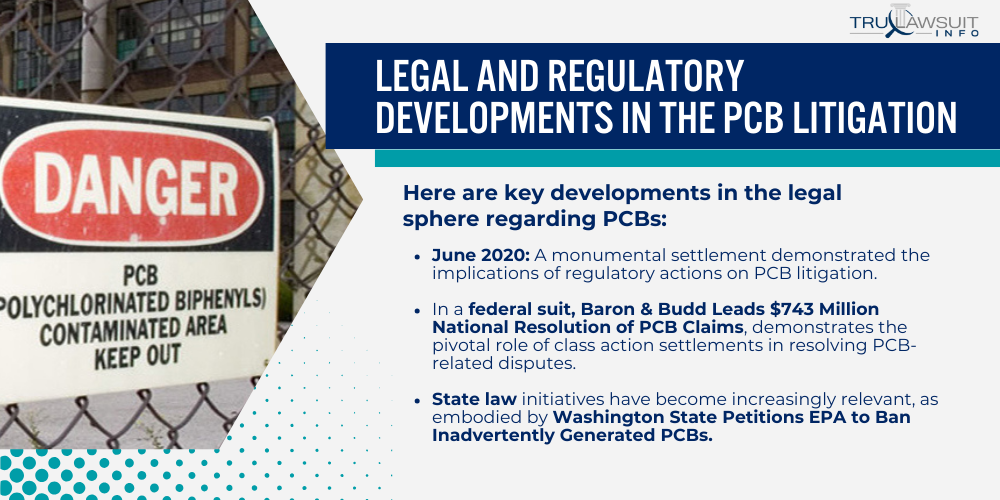
These are directly influencing the progression and outcomes of actions brought forth by municipal and state entities.
Recent Amendments and EPA Regulations
The legal landscape has been significantly affected by changes to the Toxic Substances Control Act (TSCA), which is the primary regulatory mechanism for chemical substances.
The Environmental Protection Agency (EPA) oversees the enforcement of TSCA, which includes the management of polychlorinated biphenyls (PCBs), a group of man-made organic chemicals.
As these substances have been identified as environmental and health hazards, maintaining compliance with TSCA’s amendments and EPA’s regulatory standards is crucial for all stakeholders.
Here are key developments in the legal sphere regarding PCBs:
- June 2020: A monumental settlement demonstrated the implications of regulatory actions on PCB litigation. Bayer reached a settlement confirming its liability for PCB contamination, as highlighted in Managing and Mitigating the U.S. PCB Litigation Risk.
- In a federal suit, Baron & Budd Leads $743 Million National Resolution of PCB Claims, demonstrates the pivotal role of class action settlements in resolving PCB-related disputes.
- State law initiatives have become increasingly relevant, as embodied by Washington State Petitions EPA to Ban Inadvertently Generated PCBs. The petition aims to reduce allowances for unintentional PCBs in consumer products, indicating a stricter stance at the state level.
- Summary judgments have significant bearing in PCB litigation by potentially concluding cases swiftly without a trial, as evident in cases where claims of PCB impairment are clear-cut and sufficient evidence is presented.
- The scope of claims arising from PCB litigation often extends to environmental impairments and health risks associated with other hazardous substances found alongside PCBs.
- Actions in state courts emphasize the role local jurisdictions play in shaping the trajectory of PCB litigation, often taking into account the unique conditions and legal precedent within the state.
As the regulatory environment adapts to new scientific findings and public health considerations, these amendments and regulations will continue to guide the conduct of those involved in PCB litigation.
Lawyers, government entities, and private companies need to stay up-to-date with these changes to manage the liabilities and responsibilities associated with PCB contamination effectively.
Technological Advancements: PCB Removal
Recent technological progress in the remediation industry has led to more effective methods for removing polychlorinated biphenyls (PCBs).
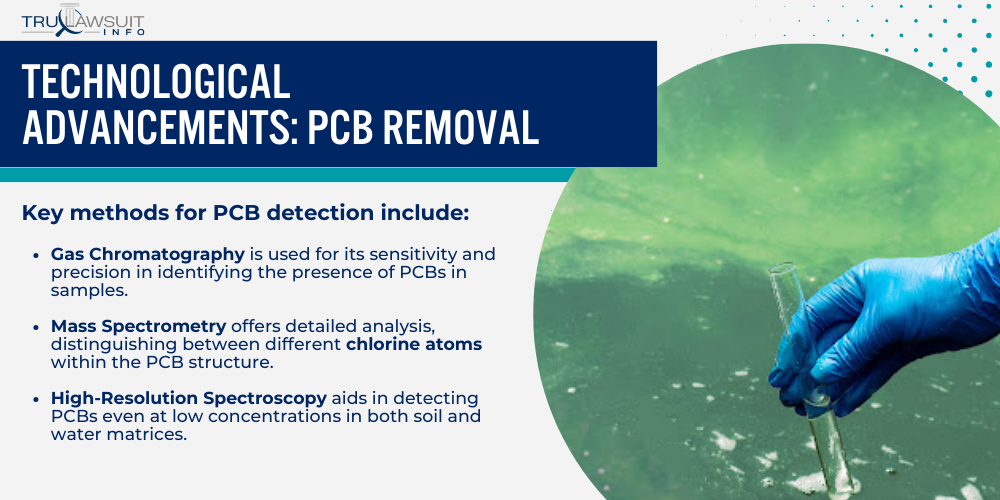
These advances are crucial considering the presence of PCBs in various materials and equipment, such as electrical transformers, hydraulic fluids, and fluorescent lighting fixtures.
Detection and Measurement of PCBs
Before the removal process begins, accurate PCB molecule detection and measurement are essential.
The industry has developed a range of sophisticated techniques to identify PCBs in contaminated environments.
Key methods for PCB detection include:
- Gas Chromatography is used for its sensitivity and precision in identifying the presence of PCBs in samples.
- Mass Spectrometry offers detailed analysis, distinguishing between different chlorine atoms within the PCB structure.
- High-resolution spectroscopy aids in detecting PCBs even at low concentrations in both soil and water matrices.
- Immunoassay Tests are cost-effective, rapid screenings for initial assessments of PCB contamination.
Each method brings its own advantages and is selected based on the specifics of the contamination site and analysis requirements.
These technologies enable stakeholders to better understand the extent of contamination and plan appropriate remediation strategies.
Future Outlook: PCB Chemical Ban
With PCB production already halted, the focus has shifted to the legacy of hazardous substances and toxic contamination.

Ongoing litigation and emerging concerns represent a reactive approach to a problem that continues to have repercussions.
Ongoing Litigation: PCB Exposure Lawsuit
Current legal actions, such as those involving Monsanto Company, Pharmacia LLC, and outside counsel, continue to navigate the complex aftermath of PCB usage.
Judge Jones and other members of the judiciary are tasked with evaluating claims of significant harm resulting from the exposure to PCBs.
The following list highlights some of the key ongoing legal cases and their features:
- Litigants allege significant harm due to PCB exposure from products made prior to the 1979 ban.
- Cases often involve multiple plaintiffs from varied backgrounds, including workers exposed to PCBs and residents of areas with contaminated sites.
- Washington State has present suits tying PCB contamination to Monsanto’s historical practices.
- The outcome of these cases could set a precedent affecting future claims and highlight the importance of toxic substance control.
Emerging Concerns in the PCB Litigation
The long-ranging effects of PCBs in the environment continue to prompt new areas of concern.
Below are current and emerging considerations directly related to the legacy of PCBs:
- The scope of environmental impact from PCBs is still being ascertained, with new sites of contamination regularly identified.
- Piecemeal litigation suggests a need for a more comprehensive approach to addressing the widespread nature of PCB pollution.
- The scientific community’s understanding of the health impacts related to PCBs has evolved, leading to new medical monitoring and remediation efforts.
- Regulations and guidelines regarding toxic contamination cleanup and restitution are under constant review to better reflect the nuances of PCB impacts.
Frequently Asked Questions
-
Long-term exposure to PCBs has been associated with severe health issues.
Individuals exposed to PCBs may face an increased risk of cancer, reproductive problems, and immune disorders.
-
To qualify for a PCB litigation settlement, an individual must typically demonstrate that they were adversely affected by PCBs.
This usually involves providing evidence of exposure and related health complications.
-
Several PCB litigations have resulted in substantial settlements.
For instance, recently, Bayer reached a settlement involving a class of municipal entities with the necessary court approvals obtained.
-
If an individual believes they are affected by PCB contamination, they should immediately consult with a healthcare professional.
They may also consider contacting an environmental lawyer to discuss potential legal actions.
-
Monsanto was historically a major producer of PCBs until their ban in 1979.
The company has faced numerous lawsuits alleging responsibility for environmental and health damages due to PCB manufacturing and distribution.

Attorney Jessie Paluch, founder of TruLawsuit Info, has over 25 years of experience as a personal injury and mass tort attorney, and previously worked as an international tax attorney at Deloitte. Jessie collaborates with attorneys nationwide — enabling her to share reliable, up-to-date legal information with our readers.
Legally Reviewed
This article has been written and reviewed for legal accuracy and clarity by the team of writers and legal experts at TruLawsuit Info and is as accurate as possible. This content should not be taken as legal advice from an attorney. If you would like to learn more about our owner and experienced injury lawyer, Jessie Paluch, you can do so here.
Fact-Checked
TruLawsuit Info does everything possible to make sure the information in this article is up to date and accurate. If you need specific legal advice about your case, contact our team by using the chat on the bottom of this page. This article should not be taken as advice from an attorney.
You can learn more about the PCB Exposure Lawsuit by visiting any of our pages listed below:
Here, at Tru Lawsuit Info, we’re committed to helping victims get the justice they deserve.
To do this, we actively work to connect them with attorneys who are experts in litigating cases similar to theirs.
Table of Contents
Tru Lawsuit Info is a reliable source of information about issues that may affect your health and safety, such as faulty products, data breaches, and environmental hazards.
Our team of experienced writers collaborates with medical professionals, lawyers, and advocates to produce informative articles, guides, and other resources that raise awareness of these topics.
Our thorough research provides consumers with access to reliable information and updates on lawsuits happening around the country. We also can connect consumers with attorneys if they need assistance.
Here, at Tru Lawsuit Info, we’re committed to helping victims get the justice they deserve.
To do this, we actively work to connect them with attorneys who are experts in litigating cases similar to theirs.
